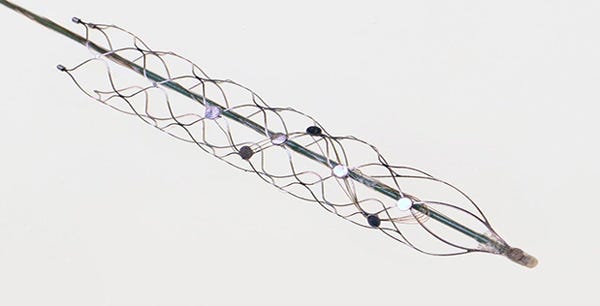How to Turn Stents Into Brain-Computer Interfaces
February 24, 2016
DARPA-funded Australian researchers have hit upon an intriguing brain-computer interface solution: stents souped up with electrodes.
Nancy Crotti
What do you get when you cross a stent with a bunch of electrodes? It is a "stentrode," a minimally invasive brain implant made from off-the-shelf components to help patients with physical disabilities and neurological disorders to move their limbs.
The size of a paper clip, the stentrode is the latest installment in DARPA-funded efforts to create a brain-computer interface, according to a statement from the agency. Placing it in the brain via the circulatory system alleviates the need for craniotomy and breaching the blood-brain barrier.
Researchers at the University of Melbourne's (Australia) vascular bionics laboratory added electrodes to off-the-shelf stents and threaded them through blood vessels into the motor cortexes brains of sheep. Once implanted, the electrodes could detect electrical signals generated by upper-motor neurons in the brain that indicate information about movement, the agency said.
The devices worked in freely moving sheep for 190 days, hinting at the possibility for safe, long-term use. The researchers made the devices flexible enough to safely pass through curving blood vessels, yet stiff enough to deliver the electrode array within the brain.
"By reducing the need for invasive surgery, the stentrode may pave the way for more practical implementations of those kinds of life-changing applications of brain-machine interfaces," said Doug Weber, program manager for DARPA's Reliable Neural-Interface Technology (RE-NET) program.
An article about the work appeared in the journal Nature Biotechnology.
The stentrode represents one of many research efforts into brain interfaces. British and Italian researchers are working on making electrodes from two-dimensional, nanoscale carbon to treatparalysis. Brown University researchers have developed a wireless transmitter that could give paralyzed patients a practical way to control various electronic devices with their thoughts.
Doctors from Case Western Reserve University in Ohio invented technology that restored movement to a man's once-paralyzed limb via a wireless brain implant that bypasses his injured spine. An international team of researchers has even created nanoscale electronic scaffolds that can be injected into the brain via syringe.
DARPA developed RE-NET a decade ago to develop neural interfaces to extract information from the nervous system to control devices such as high-performance prosthetic limbs. The first human trial of the stentrode is scheduled for 2017 at the Royal Melbourne Hospital in Melbourne.
Check out more medtech-related electronics advances>>
Learn more about cutting-edge medical devices at MD&M East, June 14-15, 2016 in New York City. |
Nancy Crotti is a contributor to Qmed and MPMN.
Like what you're reading? Subscribe to our daily e-newsletter.
About the Author(s)
You May Also Like





